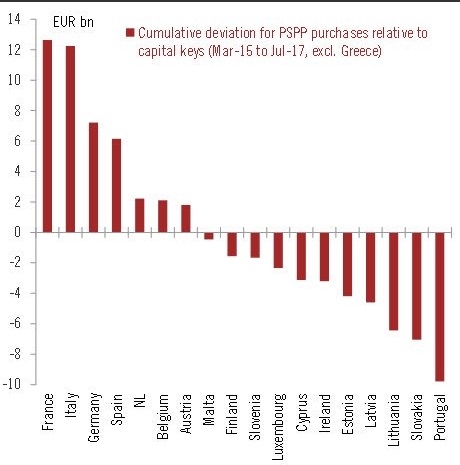When the European Central Bank (ECB), the latecomer in the Quantitative Easing (QE) program announced its Public Sector Purchase Program (PSPP) in 2015, it was said that the program would follow the central bank’s capital key structure. The structure is based on individual countries or central bank’s contribution to European Central Bank’s (ECB) base capital. However, in reality, after years of PSPP, the deviation from key capital ratio is quite large and the gap is likely to grow if ECB continues further on its bond buying program.
According to data, while ECB bought more bonds than key capital for Italy, France, Germany, Spain, Netherlands, and Belgium, it has bought lesser amounts than the key capital for rest of the Eurozone. ECB didn’t buy any Greek bonds. The gap is highest for Franc and Italy with around €12 billion. And on the downside, the gap is largest for Portugal (approx. €10 billion).
The gap could continue for many economies and even expand if ECB continues to expand its balance sheet without changing the current rules. To give an example, as of now, ECB has bought €10 billion less of Portugal bonds than key capital ratio requires but the current bond purchase has already hit 30 percent issuer limit, whereas the rules bar ECB from buying more than 33 percent bonds for any issuer.



 Why central banks should stop raising interest rates
Why central banks should stop raising interest rates  The Federal Reserve held off hiking interest rates
The Federal Reserve held off hiking interest rates  Will the RBA raise rates again? Unless prices surge over summer, it's looking less likely
Will the RBA raise rates again? Unless prices surge over summer, it's looking less likely  The RBA has kept interest rates on hold. Here's why it'll be cautious from here on
The RBA has kept interest rates on hold. Here's why it'll be cautious from here on  Why the Bank of England is now more upbeat than the IMF
Why the Bank of England is now more upbeat than the IMF  Interest rates: Monetary policy is always political as central banks opt to back the financial sector
Interest rates: Monetary policy is always political as central banks opt to back the financial sector  If central banks don't start cutting them soon, it could actually increase inflation
If central banks don't start cutting them soon, it could actually increase inflation 
































